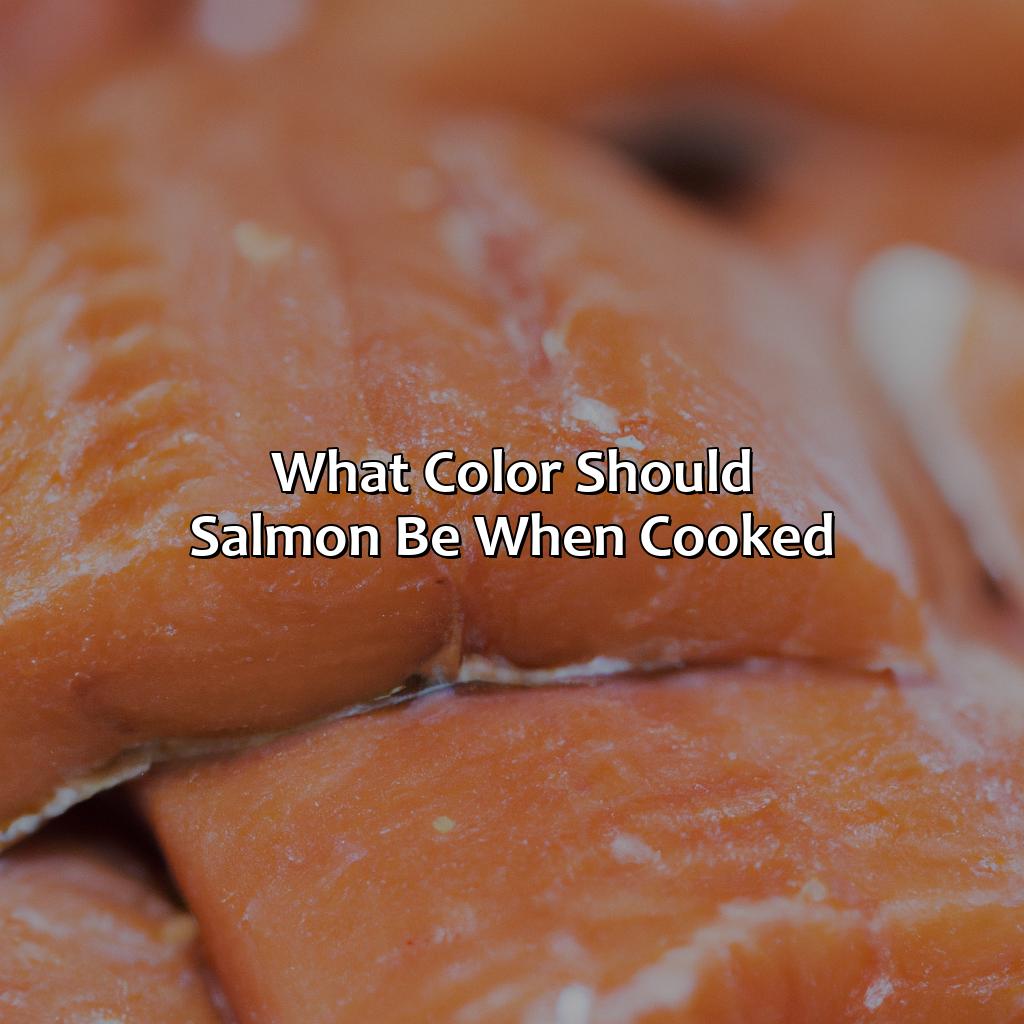Have you ever stared at a salmon fillet in the pan, unsure if it’s done? The anxiety starts to creep in, wondering if you’ve overcooked it and turned the beautiful pink flesh into a dry, crumbly mess. Don’t worry – we’ve all been there. But fear not, fellow food enthusiasts! We’re here to demystify the world of cooked salmon and unlock the secrets to achieving that perfect, juicy pink hue that will make your taste buds sing.

Image: globalseafoods.com
For many, the fear of overcooking salmon stems from a misconception about its ideal color. The truth is, just like a perfectly ripened peach, a beautifully cooked salmon reveals its deliciousness through a captivating range of colors. So, let’s dive into the world of salmon cooking, explore the colors, and learn how to achieve that ideal pink perfection.
Understanding the Color Spectrum of Cooked Salmon
Salmon, a wondrous fish packed with omega-3 fatty acids and a rich, delicate flavor, goes through a transformation when exposed to heat. As the internal temperature rises, the proteins in the fish begin to denature. This process alters the texture and, most importantly, the color.
From Raw to Pink: The Journey of Color
When raw, salmon boasts a vibrant, almost translucent reddish-orange color. This hue comes from the presence of astaxanthin, a powerful antioxidant found in the fish’s diet. As the fish cooks, the astaxanthin molecules start to change. This is where the magic begins.
The Ideal Pink: The Sign of Doneness
The perfect cooked salmon is a symphony of pinks. It transitions from a vivid, almost coral-like hue at the edges to a softer, pale pink in the center. This gradient indicates that the fish has achieved the ideal internal temperature of 145 degrees Fahrenheit (63 degrees Celsius).

Image: colorscombo.com
Overcooked Salmon: A Culinary Faux Pas
If you’re not careful, you can easily overcook salmon. The telltale sign of an overcooked salmon is its dull, pale-white color. The protein has been over-denatured, resulting in a dry, crumbly texture and a flavor that’s lost its delicate finesse.
What Does the Color of Cooked Salmon Tell You?
While the color serves as a visual indicator of doneness, it’s crucial to remember that it’s not the sole factor.
Beyond Color: The Importance of Texture and Flaking
The texture is another reliable indicator. A perfectly cooked salmon will have a firm but still tender texture. You should be able to easily flake the fish with a fork. Conversely, overcooked salmon will be tough, dry, and may crumble when poked with a fork.
Internal Temperature: The Golden Standard of Doneness
While color and texture offer valuable clues, the most accurate way to gauge doneness is by measuring the internal temperature. A digital thermometer inserted into the thickest part of the fish should register 145 degrees Fahrenheit (63 degrees Celsius). This ensures the salmon is cooked safely and offers the best possible texture and flavor.
Tips for Achieving Perfectly Pink Salmon
Fret not, dear culinary adventurers! Achieving the perfect pink salmon is not as daunting as it may seem. Here are some tips to guide you towards salmon perfection:
1. Start with High-Quality Salmon
The quality of your salmon plays a significant role in the final product. Choose fresh salmon whenever possible. A vibrant, reddish-orange color, firm texture, and a pleasant ocean-like aroma indicate high quality.
2. Don’t Overcook It!
Remember, less is more when it comes to cooking salmon. Because heat can dry out the fish, it’s better to err on the side of undercooking than overcooking.
3. Utilize a Thermometer
A digital thermometer is your ultimate ally. It provides a precise measurement of the internal temperature ensuring that your salmon is perfectly cooked to the ideal 145 degrees Fahrenheit (63 degrees Celsius).
4. Consider Different Cooking Methods
Experiment with different cooking methods to find your favorite! Whether you prefer grilling, baking, or pan-searing, the key is to watch the internal temperature closely and stop cooking when it reaches the desired temperature.
5. Experiment with Seasoning
Don’t be afraid to get creative with your seasonings! Lemon juice, herbs, garlic, and spices add a burst of flavor to your salmon.
Expert Insights: A Culinary Master’s Guide to Salmon Perfection
We reached out to the renowned Chef Michael, a culinary master with decades of experience working with salmon. He shared his invaluable insights:
“The key to perfect salmon is all about treating it with respect,” Chef Michael says. “Avoid overcooking it. You want to aim for a gentle cooking method, such as grilling, baking, or pan-searing, that allows the fish to cook evenly and retain its moist, tender texture.”
“A good rule of thumb is to cook salmon for only a few minutes per side,” Chef Michael adds. “This ensures that the fish is cooked through while retaining its delicate flavors and vibrant pink color.”
What Color Should Salmon Be When Cooked
Conclusion: A Journey to Salmon Mastery
The color of cooked salmon is a mesmerizing indicator of its doneness. That beautiful pink hue signifies a perfect balance between texture and flavor. Armed with the knowledge of color, texture, and internal temperature, you are now equipped to confidently navigate the waters of salmon cooking. Remember, with a little practice and the right tools, you can master the art of creating perfectly pink, juicy, and flavorful salmon dishes that will delight your palate and impress your guests. So, embark on your culinary adventure, explore the world of salmon, and discover the joy of a perfectly cooked fish.






